What Is A Capacitor?
Capacitors are common components in guitar pedals and, after resistor use in guitar pedals, are usually one of the components you’ll see and use the most when building guitar pedals.
Capacitors store electricity, but they do so in a different way to how batteries store electricity. While batteries slowly let out electricity to power something, capacitors quickly release a burst of energy. This can be useful for things like camera flashes where a large burst of electricity is needed quickly, but only for a short time.
In guitar pedals, capacitors are also often used to filter signals. This filtering aspect can be used to modify and shape the tone of the sound coming out of the guitar pedal. I’ll go through this later in the article as I explain the different ways capacitors are used in guitar pedals.
In a wiring diagram, capacitors look like this (U.S. version on the left, international on the right)
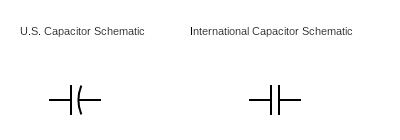
As you can see, capacitors can be either polarised or not polarised. A non-polarised capacitor can be used in any orientation. However, a polarised capacitor needs to put in the orientation shown on the wiring diagram. To know which side of a polarised capacitor is positive, you just need to look at the wires; the longer one is positive.
How Are Capacitors Measured?
A capacitor’s capacitance is measured in Farads. One Farad is quite a lot, so when making guitar pedals, you’ll often be using capacitors with values in the micro or nano Farad range, or even picoFarads.
Capacitors also have a voltage rating. This is simply how much voltage the capacitor is rated for. Generally speaking, this isn’t a huge concern for guitar pedal making since we’re usually working with low voltages. Generally speaking though, a capacitor with a higher voltage rating will be physically larger than a capacitor with the same capacitance that has a lower voltage rating. Space is often at a premium in guitar pedal circuits, so try to use capacitors with as low a voltage rating as possible.
What Are The Different Kinds Of Capacitors?
Capacitors can be made of different materials and look very different from one another. You will have noticed that resistors used in guitar pedals pretty much all look quite similar, capacitors on the other hand come in all different shapes and sizes!
Ceramic Capacitors
Ceramic capacitors are usually the smallest capacitors that are used and are usually in the picoFarad range.
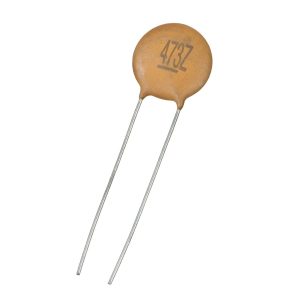
While you’ll find ceramic capacitors used in guitar pedals, both for professionally made guitar pedals and DIY guitar pedals, they’re used a lot less often than other types of capacitors. This is because ceramic capacitors can have a few interference issues. They’re used, and there’s nothing wrong with using them, it’s just that they’re not used as frequently as other capacitors in guitar pedals.
Polyester, Box, and Metal Film Capacitors
These types of capacitors are used quite a lot in making guitar pedals, and you’ll probably get familiar with them quite quickly!
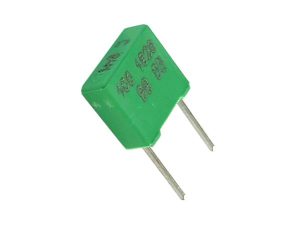
As you can see from the picture, these capacitors are usually a boxy shape. They’re usually a mid-range capacitance when compared to other capacitors used in guitar pedals.
Electrolytic Capacitors
Electrolytic capacitors are commonly used in guitar pedals and are always polarised. As mentioned, you can tell which side of the capacitor is polarised because one of the wires is longer. There are also often markings on the outside of the capacitor to indicate which side is positive.
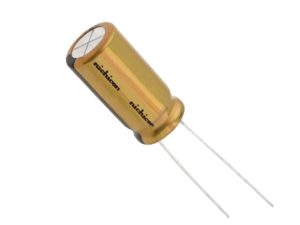
Don’t make the mistake of orienting an electrolytic capacitor the wrong way. You likely won’t destroy anything, but your pedal won’t work.
Electrolytic capacitors are usually of higher values when compared to other capacitors used in guitar pedal making.
Reading A Capacitor’s Value
While electrolytic capacitors often have their value printed on them, smaller capacitors may just have a code on them to save space.
Decoding a capacitor’s value isn’t difficult, but the answer is kind of long winded. Rather than rewriting the myriad of articles on how to read a capacitor code, here’s a good resource. If you don’t want to work it out yourself, there’s also plenty of online calculators available that will decode capacitor values for you. Here’s a good one.
Understanding Capacitors In Parallel And In Series
Along with other components, you’ll see capacitors used either in series or in parallel, and their total capacitance will vary depending on how they’re arranged.
Capacitors in series look like this:
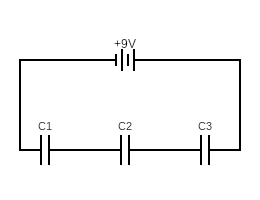
To calculate the total capacitance the equation is:
This equation will work with any number of capacitors in series.
Capacitors in parallel look like this:
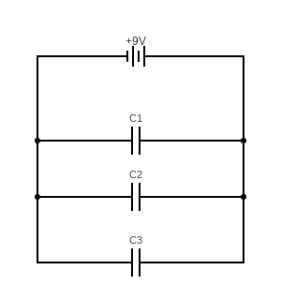
To calculate the total capacitance the equation is:
Again, this works with any number of capacitors.
Obviously most guitar pedal circuits are going to be more complicated than the simple diagrams above. You’ll likely see capacitors (and other guitar pedal components) in both series and parallel, but you should start with understanding the more simple diagrams first.
How Do Capacitors Work?
A capacitor is simply two conducting plates with a small separation between them. The separation can either be filled with an insulator or just be empty space. The insulator between the plates can be made of various things including plastic, glass, and liquids. It just depends on what the capacitance and voltage rating needs to be.
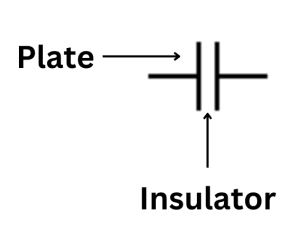
Speaking basically, charge builds up on one of the plates; when the conditions are right, that charge will then start to flow to the other plate. This flow is very fast at first, but gets gradually slower over time.
An example I’ve seen of this is with a light bulb. If a capacitor is charged using a battery, then discharged into a light bulb (with the battery removed), the light bulb will start out bright and then start to slowly fade as the capacitor loses charge.
Another thing about capacitors is that AC current can pass through them without being affected. This is because, as the name suggests, alternating current (AC) alternates its polarity to each side of the capacitor
Safely Discharging A Capacitor
Since a capacitor can hold a charge, it’s possible to inadvertently charge one up when testing a circuit and for it to still have charge when you go to remove it. This can lead to electric shocks, which can be dangerous with higher capacity capacitors.
Fortunately capacitors used in making guitar pedals are generally quite low, but you can still hurt yourself.
To stay on the safe side, discharge capacitors when you handle them. To do this, you can safely touch the casing of the capacitor, just don’t touch the wires. Touch these wires to a 10K ohm resistor and the charge should be released.
Enjoying This Component Guide?
Learn more about capacitors and other guitar pedal components.
What Do Capacitors Do In A Guitar Pedal?
Capacitors do a lot of things in a guitar pedal circuit! It you’ve already read my guide to resistors in guitar pedals, you’ll already know about high pass and low pass filters, but they also do so much more. Let’s take a look.
Resistor-Capacitor (RC) Filter
A resistor-capacitor filter (or RC filter for short) is kind of what it sounds like: a filter made with a resistor and capacitor in series. These filters can be made to either make a high pass/low cut filter or a low pass/high cut filter. These filters, as their names would suggest, let high or low frequencies through while cutting other frequencies. Having RC filters in a guitar pedal allows you to shape the tone of the sound, emphasising higher or lower frequencies.
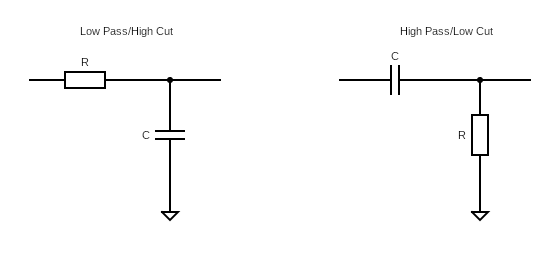 To determine the cutoff frequency, the formula is:
To determine the cutoff frequency, the formula is:
Where R is the resistance and C is the capacitance.
This can be a static filter if you want to filter a specific frequency, or a potentiometer can be used as a variable resistor, allowing the tone to be shaped by varying the resistance through the potentiometer.
If you’re after more information on high/low pass filters, here’s my guide to high pass and low pass filters in guitar pedals.
Regulating And Smoothing Power Supply
Smoothing out the power supply is another common use of capacitors in guitar pedals.
As mentioned, a capacitor charges up over time, and then begins to discharge when the power to it is cut. This discharge is fast at first then slows down over time.
One use for this in guitar pedals is that when AC current is converted to DC current, there are still dips in the voltage from the AC oscillations. Having a capacitor in place smooths out these dips, keeping the power flow more even and eliminating noises in the circuit.
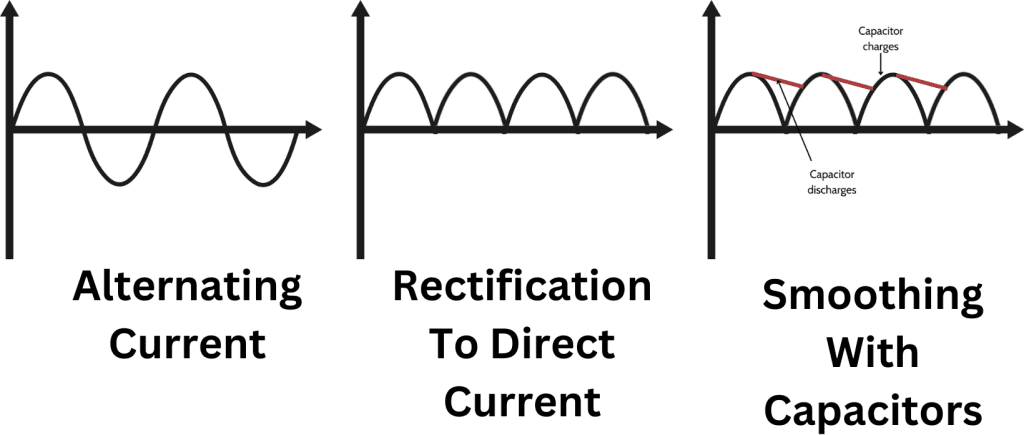
And I’m sure you agree, having a good and constant power supply to your pedal is important!
Coupling Capacitors
As mentioned, capacitors will block DC while allowing AC to flow through them. The signal from a guitar is AC, while the current in the actual pedal is DC; if these mix there can be interference and noise in the pedal, which is obviously bad.
To prevent DC from flowing back into AC sections of the circuit, a coupling capacitor can be used. This is why you often see a capacitor just after the input in guitar pedal wiring diagrams.
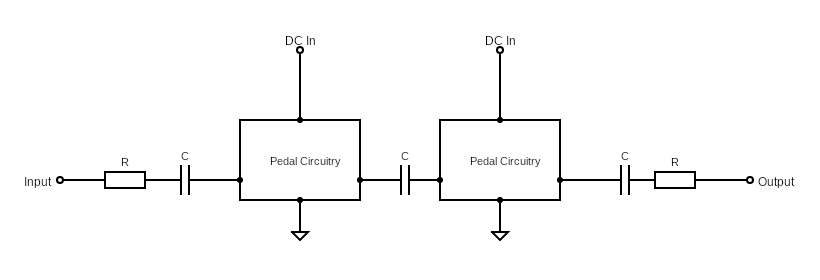
You’ll also frequently see a coupling capacitor between specific sections of a pedal’s circuitry. This isolates the DC power being used in that section while allowing the AC signal of the guitar signal to move through to the next stage.
Summing Up
Capacitors have many uses in guitar pedal design and building, whether you’re creating an RC filter, smoothing out power, or preventing power from flowing somewhere it shouldn’t be. Like resistors, when first looking at wiring diagrams for guitar pedals, some of the capacitor placement can seem arbitrary, but everything has a purpose.
Hopefully this article has shone a light on the important role capacitors have in guitar pedals, and that you can better understand wiring diagrams, DIY guitar pedal building, and even designing and modifying your own pedal builds.
Related posts:
 What Are Coupling Capacitors?
What Are Coupling Capacitors?
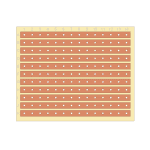 What Is Stripboard And How Do You Read Layouts?
What Is Stripboard And How Do You Read Layouts?
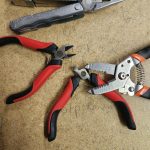 Should I Make Guitar Pedals On Stripboard Or PCBs?
Should I Make Guitar Pedals On Stripboard Or PCBs?
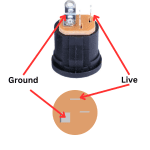 How To Wire A Guitar Pedal DC Power Jack
How To Wire A Guitar Pedal DC Power Jack
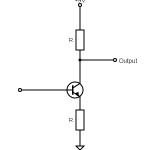 What Is Transistor hFE?
What Is Transistor hFE?
 The Difference Between SPDT, DPDT, And 3PDT Switches And How To Use Them
The Difference Between SPDT, DPDT, And 3PDT Switches And How To Use Them
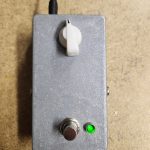 A Versus B Potentiometers (And When To Use Them)
A Versus B Potentiometers (And When To Use Them)
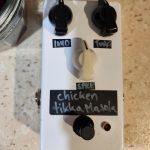 How Do Guitar Pedal (And Guitar) Volume Knobs Work?
How Do Guitar Pedal (And Guitar) Volume Knobs Work?
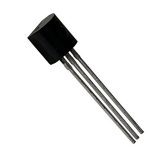 The Difference Between Silicon And Germanium Transistors
The Difference Between Silicon And Germanium Transistors
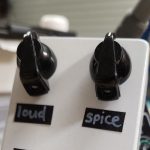 How Does A Drive, Gain, Or Distortion Knob Work?
How Does A Drive, Gain, Or Distortion Knob Work?
